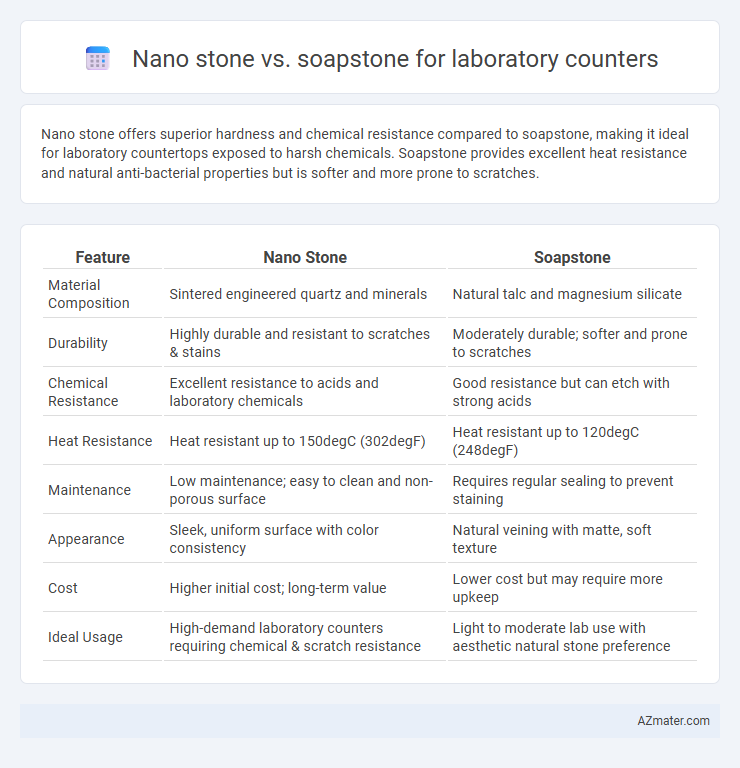Nano stone offers superior hardness and chemical resistance compared to soapstone, making it ideal for laboratory countertops exposed to harsh chemicals. Soapstone provides excellent heat resistance and natural anti-bacterial properties but is softer and more prone to scratches.
Table of Comparison
| Feature | Nano Stone | Soapstone |
|---|---|---|
| Material Composition | Sintered engineered quartz and minerals | Natural talc and magnesium silicate |
| Durability | Highly durable and resistant to scratches & stains | Moderately durable; softer and prone to scratches |
| Chemical Resistance | Excellent resistance to acids and laboratory chemicals | Good resistance but can etch with strong acids |
| Heat Resistance | Heat resistant up to 150degC (302degF) | Heat resistant up to 120degC (248degF) |
| Maintenance | Low maintenance; easy to clean and non-porous surface | Requires regular sealing to prevent staining |
| Appearance | Sleek, uniform surface with color consistency | Natural veining with matte, soft texture |
| Cost | Higher initial cost; long-term value | Lower cost but may require more upkeep |
| Ideal Usage | High-demand laboratory counters requiring chemical & scratch resistance | Light to moderate lab use with aesthetic natural stone preference |
Introduction to Laboratory Countertop Materials
Nano stone offers exceptional durability and resistance to chemicals, making it ideal for laboratory countertops requiring high performance under harsh conditions. Soapstone provides natural heat resistance and non-porous properties, minimizing contamination risks and ensuring ease of maintenance. Both materials cater to laboratory environments, but nano stone excels in strength while soapstone emphasizes chemical neutrality and warmth.
Overview of Nano Stone and Soapstone
Nano stone offers exceptional hardness and non-porous surface qualities, making it resistant to stains and chemical damage, ideal for laboratory counters requiring durability and hygiene. Soapstone, composed mainly of talc and magnesium silicate, provides excellent chemical resistance and heat tolerance but is softer and more prone to scratches and wear. Both materials are favored for laboratory countertops; nano stone excels in long-term durability and maintenance, while soapstone offers natural chemical inertness and thermal stability.
Material Composition and Properties
Nano stone laboratory counters consist of engineered quartz and natural minerals with a high-density polymer resin, offering exceptional hardness, non-porosity, and resistance to stains and chemicals. Soapstone is a natural metamorphic rock composed primarily of talc and magnesium silicate, characterized by its softness, chemical resistance, and excellent heat resistance but is more prone to scratching and requires periodic sealing. Nano stone provides greater durability and minimal maintenance ideal for high-traffic lab environments, whereas soapstone offers superior chemical inertness and heat endurance but demands more care to maintain its surface integrity.
Durability and Resistance to Chemicals
Nano stone laboratory counters exhibit exceptional durability and high resistance to a wide range of chemicals, making them ideal for harsh lab environments. Soapstone offers natural chemical resistance, especially to acids, but is softer and more prone to scratching and etching compared to nano stone. Laboratories requiring long-lasting, low-maintenance surfaces often prefer nano stone for its superior hardness and enhanced chemical stability.
Heat and Stain Resistance Comparison
Nano stone exhibits superior heat resistance, withstanding temperatures up to 700degF without damage, making it highly suitable for laboratory counters exposed to frequent heat exposure. Soapstone offers moderate heat resistance around 480degF but may develop discoloration or etching over time under intense heat. In terms of stain resistance, nano stone's non-porous surface prevents absorption of chemicals and spills, whereas soapstone's slightly porous nature requires regular sealing to maintain its stain-resistant properties.
Maintenance and Cleaning Requirements
Nano stone offers exceptional durability and stain resistance, requiring minimal maintenance with only periodic wiping using mild detergents, making it highly suitable for laboratory counters exposed to chemicals. Soapstone demands more frequent maintenance, including regular oiling to preserve its protective patina and prevent staining from spills common in lab environments. Both materials resist chemical corrosion, but nano stone's non-porous surface significantly reduces cleaning time and the risk of contamination compared to the more porous soapstone.
Aesthetic Options and Customization
Nano stone offers a sleek and modern aesthetic with a wide range of vibrant colors and patterns ideal for laboratory counters requiring precise customization. Soapstone features a natural, matte finish with subtle veining, providing a timeless look but with more limited color variations compared to nano stone. Both materials allow for tailored sizing and edge profiles, yet nano stone's engineered composition enables finer detailing and more consistent texture for specialized laboratory environments.
Cost Analysis: Nano Stone vs Soapstone
Nano stone countertops typically cost between $50 to $75 per square foot, offering a durable, non-porous surface ideal for laboratory environments. Soapstone, priced around $70 to $100 per square foot, provides excellent chemical resistance and heat durability but requires periodic sealing to maintain its integrity. Considering installation and maintenance expenses, nano stone often presents a more cost-effective and low-maintenance option compared to soapstone for laboratory counters.
Environmental Impact and Sustainability
Nano stone countertops offer a highly sustainable option due to their durability and low maintenance, significantly reducing the need for replacements and chemical cleaners that harm the environment. Soapstone, a natural material, boasts excellent environmental credentials by being non-toxic, long-lasting, and easily recyclable, with minimal processing that limits carbon emissions. Both materials support eco-friendly laboratory designs, yet soapstone's entirely natural origin often positions it as the greener choice in terms of lifecycle sustainability.
Conclusion: Choosing the Right Laboratory Countertop
Nano stone offers superior chemical resistance and durability, making it ideal for high-usage laboratory countertops where contamination and wear are concerns. Soapstone provides excellent heat resistance and natural antibacterial properties, suitable for labs requiring frequent exposure to heat and chemicals. Selecting the right laboratory countertop depends on specific needs: choose nano stone for long-lasting, low-maintenance surfaces, or soapstone for its heat tolerance and organic aesthetic.

Infographic: Nano stone vs Soapstone for Laboratory Counter
 azmater.com
azmater.com